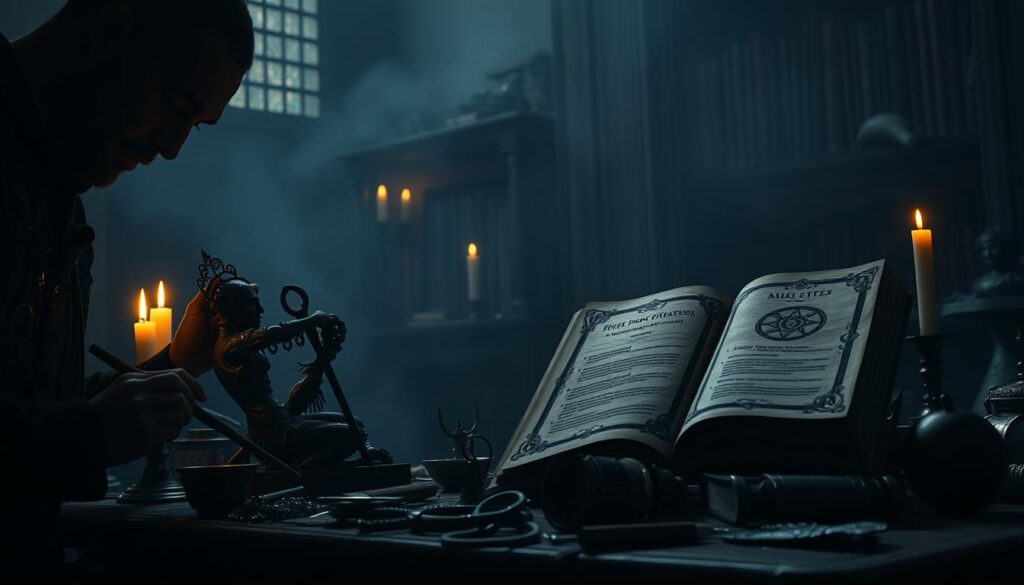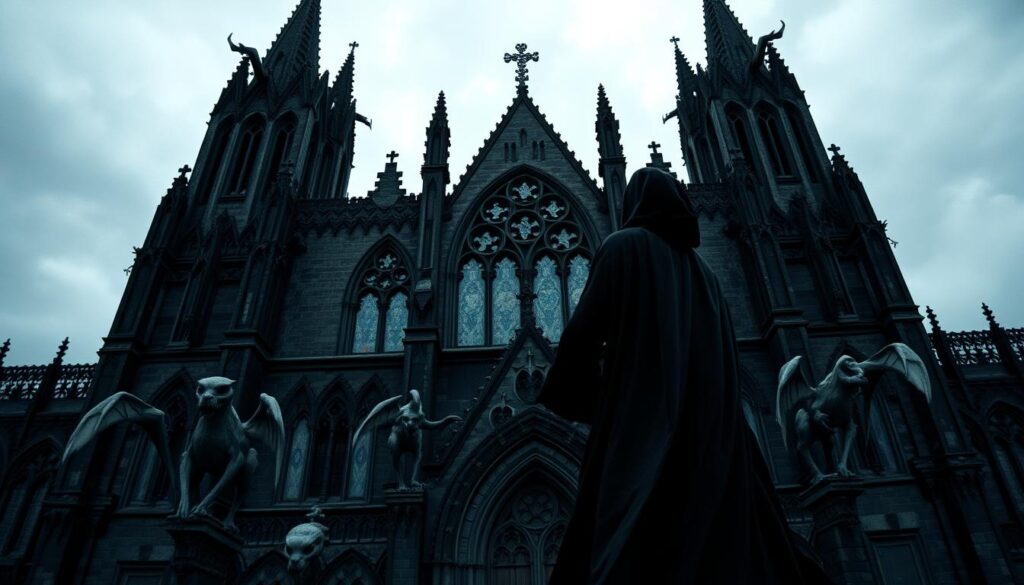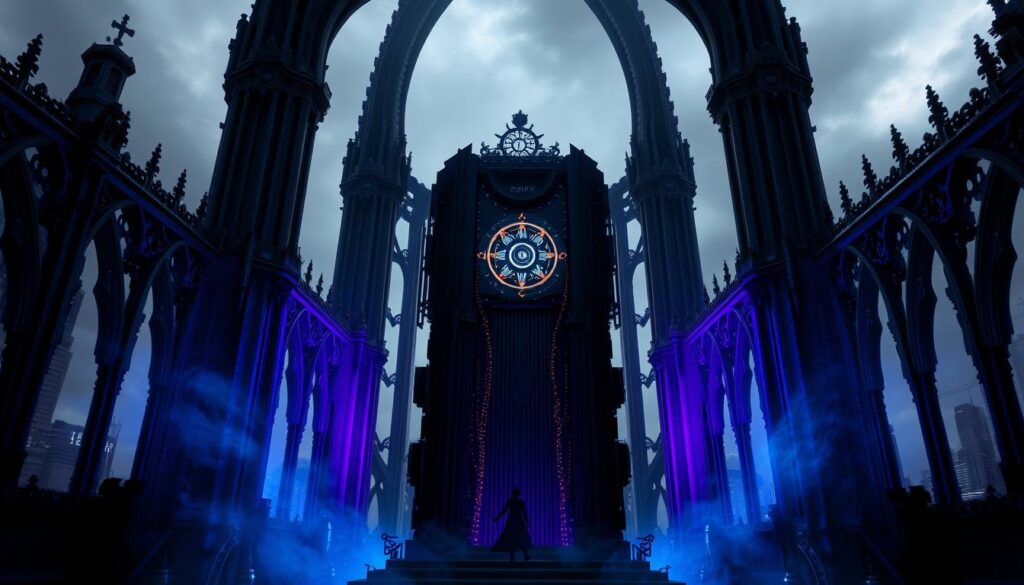5 Powerful gothic ai Tools That Inspire Dark Art Creation
14 min read
Table of Contents
The world of art has always been drawn to the mysterious and unknown. With artificial intelligence, creators can now explore new realms of inspiration. Dark art, with its detailed and haunting beauty, has become very popular.
Now, you can create eerie landscapes, gothic buildings, and haunting portraits with just a few clicks. Advanced AI tools make this possible, producing stunning art.

These innovative tools are changing how artists work and opening new creative paths. In this article, we’ll look at five powerful tools that are inspiring dark art and changing the art world.
The Dark Digital Renaissance: Exploring Gothic AI
The gothic look is back in digital art, marking a new era called the Dark Digital Renaissance. This era combines old gothic styles with the latest in artificial intelligence.
The Fusion of Gothic Aesthetics and Artificial Intelligence
Gothic style AI tools are now available, making it easy for artists to create detailed designs. These tools use neural networks to make gothic art that’s both stunning and modern.

The Growing Community of Gothic Digital Artists
The rise of gothic design AI has brought together many digital artists. They love exploring the darker side of art. This group is making gothic AI even more exciting.
This movement is more than just tech. It’s a cultural shift, changing how we see and enjoy gothic art online.
Understanding Gothic AI Technology and Its Evolution
Gothic AI technology combines gothic elements with AI, creating a new form of digital art. It’s a big step forward in AI, focusing on gothic imagery. This tech uses complex algorithms and neural networks to make art that fits the gothic style.

How Neural Networks Generate Gothic Imagery
Neural networks are key in making gothic art. They learn from lots of gothic art examples. They find patterns like detailed designs, dark colors, and spooky scenes.
AI systems use this knowledge to make new gothic art. This art keeps the traditional gothic feel but also brings in fresh ideas.
Recent Breakthroughs in Gothic Style AI
New advancements in gothic AI have made the art better and more detailed. Improvements in neural networks and training have helped a lot. Now, AI can make more complex gothic images.
Key developments include clearer images, better color use, and adding specific gothic elements. These changes are making gothic digital art even more exciting and creative.
Nightcafe Creator: Transforming Concepts into Gothic Masterpieces
Nightcafe Creator is a top tool for making gothic art with AI. It’s known for creating dark, surreal art that fits the gothic style.
Key Features and Gothic-Specific Capabilities
Nightcafe Creator has features perfect for gothic art. It includes:
- Advanced text-to-image generation
- Style transfer for achieving specific gothic aesthetics
- Customizable parameters for tailoring the output to the user’s vision
Text-to-Image Gothic Generation
The text-to-image feature lets users input text. The AI then creates gothic-inspired images from it. This helps artists turn their ideas into stunning visuals.
Style Transfer for Gothic Aesthetics
Style transfer is a key feature of Nightcafe Creator. It lets users add gothic traits to their art. This means artists can make their work dark and detailed, just like gothic art.
With these tools, Nightcafe Creator is changing the world of gothic design ai and gothic style ai. It gives artists new ways to be creative.
Midjourney: The Dark Fantasy AI Generator
Midjourney is changing how we see dark fantasy art. It’s a top choice for artists and fans wanting to dive into gothic fantasy. This AI tool is making it easy to create dark, gothic art.
Midjourney excels at understanding complex prompts. This lets users make detailed, gothic art. To get the best results, learning how to use gothic prompts is key.
Gothic-Specific Prompting Techniques
To use Midjourney well, you need to know how to write gothic prompts. This means using the right keywords and tweaking parameters.
Effective Keywords for Gothic Results
Choosing the right keywords is vital for creating gothic art with Midjourney. Here are some good ones:
- Dark fantasy designed to evoke mystery and fear.
- Gothic architecture to add historical gothic touches
- Macabre elements highlight themes of death and the unknown.
- Victorian-era gothic to capture the 19th-century gothic spirit
Parameter Adjustments for Darker Aesthetics
Changing parameters can make your art even more gothic. Here’s how:
- Change the color palette to darker, more muted colors
- Up the level of detail for more complex scenes
- Play with lighting effects to set a spooky mood
With these tips, you can make amazing gothic art with Midjourney. Your creations will be both eerie and enchanting.
DALL-E2: Pushing Boundaries in Gothic Design AI
DALL-E2 is changing the game in gothic design AI. It can create many art styles, including gothic designs. These designs are detailed and beautiful, capturing the audience’s attention.
DALL-E2’s skills in gothic design AI get better with specialized gothic prompt engineering. This lets artists make specific prompts. These prompts help bring out the gothic themes and elements they want.
Specialized Gothic Prompt Engineering
Specialized gothic prompt engineering means making prompts with gothic elements. These include ornate patterns, mysterious landscapes, and eerie atmospheres. By tweaking these prompts, artists can guide DALL-E2 to create gothic art that fits their vision.
Creating Victorian Gothic Architecture
DALL-E2 is great at making Victorian Gothic architecture. Artists use prompts with details like stone carvings, pointed arches, and ribbed vaults. This way, they can create stunning images of this iconic style.
Generating Gothic Character Designs
DALL-E2 is also good at making gothic character designs. It brings characters to life with macabre elegance and dark charm. Artists can add dark clothes, mysterious accessories, and haunting expressions. This way, they can create gothic characters that truly capture the gothic spirit.
Thanks to its advanced abilities and specialized prompt engineering, DALL-E2 is expanding the limits of gothic design AI. It lets artists explore new areas in gothic art creation.
Stable Diffusion: Open-Source Gothic AI Revolution
Open-source gothic AI is booming thanks to Stable Diffusion. This tech makes advanced gothic AI tools available to all. Artists and developers can now create models that fit their unique tastes.
Custom Training for Gothic Aesthetics is what sets Stable Diffusion apart. Users can tweak models with gothic data. This leads to AI models that create detailed gothic art.
Custom Training for Gothic Aesthetics
Stable Diffusion’s flexibility is great for gothic art. It lets users fine-tune models to match their gothic style. This ensures the art looks good and fits the user’s gothic taste.
Fine-tuning Models with Gothic Datasets
Fine-tuning means training the model on gothic images. This boosts its skill in creating gothic art. It learns to use gothic motifs, textures, and colors well.
LoRA Adaptations for Gothic Styles
LoRA (Low-Rank Adaptation) is a key feature of Stable Diffusion. It lets users adapt models to specific gothic styles easily. This results in high-quality gothic AI art with little extra training.
Stable Diffusion combines custom training and LoRA for amazing gothic AI art. As it grows, we’ll see even more detailed gothic art from AI.
Stable Diffusion is changing gothic art with artificial intelligence gothic methods. Its open-source and customizable nature draws artists to explore gothic AI.
Artbreeder: Evolving Gothic Imagery Through AI
Artbreeder uses AI to let artists explore new areas in gothic art. It’s popular among digital artists for its unique way of making art. This method is great for creating detailed gothic designs.
Gene-Based Gothic Art Manipulation
Artbreeder’s system lets artists evolve their art like it’s alive. This is perfect for gothic art, which loves detailed designs.
Darkness and Contrast Controls
Artbreeder has special controls for darkness and contrast. Artists can tweak their gothic art to get the right spooky or dramatic feel. These controls help make deep shadows and highlights, key to gothic art.
Gothic Architectural Elements
Artbreeder makes it easy to add gothic architectural details to art. You can play with pointed arches, ribbed vaults, and flying buttresses. These elements can be mixed and matched to create unique gothic structures.
Here’s how Artbreeder’s features can help with gothic art:
- Adjusting gene parameters to enhance gothic features
- Using darkness and contrast controls to create dramatic effects
- Incorporating gothic architectural elements into compositions
- Experimenting with different mutations to evolve complex designs
Artists can use these tools to make new and exciting gothic art. They can show off the power of gothic style AI and gothic design AI.
The Impact of Gothic AI on Traditional Dark Art Communities
The gothic AI phenomenon is changing the dark art world. As AI-generated gothic images become more common, traditional dark art communities face both chances and hurdles.
Professional Gothic Artists’ Response to AI
Many professional gothic artists see AI as a way to boost their creativity. By using gothic AI, they can try out new styles and themes. This helps them grow their artistic range.
Some artists start with AI-generated elements and then add their own unique touches. This way, they create one-of-a-kind pieces.
Blending Traditional and AI-Generated Elements
Artists are now mixing traditional techniques with AI-generated gothic art. This mix creates innovative and captivating works. They blend AI’s precision with traditional art’s emotional depth.
This blend not only enriches the artistic process. It also opens new ways for gothic art fans to connect with the genre.
By merging traditional and AI methods, gothic artists can explore new creative heights. This leads to a more varied and vibrant dark art community.
Ethical Considerations in Gothic AI Art Creation
Gothic AI art is leading a technological revolution. But, it also raises big ethical questions. As AI art grows, the art world faces new challenges.
Copyright Issues and Original Gothic Works
Using gothic AI technology sparks debates on copyright and ownership. Who should own the rights to an AI-created gothic piece? Is it the AI developer or the user who asked for it?
The Question of Authenticity in AI Gothic Art
Authenticity in AI gothic art is a big concern. Can a machine-made piece be seen as authentic? Or does it miss the human touch that art is often valued for?
Future Trends in Gothic AI Development
Gothic AI is growing, bringing new trends to the dark art world. The mix of gothic looks with AI is creating new tools and ways for artists to work. This is changing how dark art is made and seen.
Emerging Gothic AI Technologies
Style transfer and generative models are leading the way in gothic AI. They let artists put gothic styles on different art types, making unique pieces. Also, AI-powered texture and pattern generation is getting popular. It helps artists add detailed touches to their work.
Predicted Evolution of Gothic Design AI
The future of gothic design AI looks bright. It will improve image synthesis and manipulation a lot. Soon, gothic AI will make images that look very real, mixing digital and traditional art.
Also, AI-driven art critique and analysis might become more common. This could give artists useful feedback on their work.
Conclusion: Embracing the Dark Digital Future
The journey into gothic AI tools has opened a new chapter in dark art. Artists can now make detailed, gothic-inspired works with ease thanks to AI. Tools like Nightcafe Creator, Midjourney, DALL-E2, Stable Diffusion, and Artbreeder are key in this process.
Gothic AI is changing how artists create and what they can do. It’s making the art world bigger and more exciting. The mix of gothic style and AI is set to change the digital dark scene.
As gothic AI grows, we must think about its ethics and uses. By diving into this future, artists and tech experts can make groundbreaking, gothic art. This art will explore new creative heights.
FAQ
What is Gothic AI, and how is it used in art creation?
Gothic AI uses artificial intelligence to create art with a gothic style. It combines old gothic elements with new digital methods. This way, it makes unique gothic images.
How do neural networks generate gothic imagery?
Neural networks learn from lots of gothic art. They find patterns that make gothic art special. Then, they make new images that are both unique and gothic.
What are some of the key features of NightCafe Creator for gothic art generation?
NightCafe Creator is a tool for making gothic art. It can turn text into gothic images and change styles. It has special models for creating high-quality gothic art.
How can Midjourney be used for dark fantasy art creation?
Midjourney is an AI tool for dark fantasy art. You can use special keywords and settings to make your art darker and more gothic.
What is Stable Diffusion, and how does it contribute to gothic AI?
Stable Diffusion is a tool for making gothic AI. It lets you train models on gothic art. This helps create more gothic art and supports the gothic AI community.
How is Artbreeder used for evolving gothic imagery?
Artbreeder lets you change gothic images with AI. You can adjust things like darkness and architecture to make your art unique.
What are the ethical considerations surrounding gothic AI art creation?
Creating gothic digital art raises concerns about copyright and authenticity. As AI art grows, we need to talk about these issues and set rules for using gothic AI.
How is gothic AI technology expected to evolve in the future?
Gothic AI will keep getting better with new AI and machine learning. New technologies will help make gothic AI even more advanced.
What is the impact of gothic on traditional dark art communities?
Gothic affects dark art communities in different ways. Some artists see it as a threat, while others see it as a chance to mix old and new techniques.
Can gothic tools be used for commercial purposes?
Yes, you can use gothic for business, like selling art or using it in ads. But, you should know the rules and copyright laws first.
Reader Ratings & Reviews
There are no reviews yet. Be the first one to write one.
